Before our weekend trip, we knew a gondola ride in Venice was something we had to do while visiting the city. Others had warned me that it was expensive, some even felt it wasn’t worth the price. I’m all about experiences though, they are something I feel you can’t put a price on. For us, a gondola ride through the canals of Venice was one of those bucket list experiences.
This actually ended up being one of the first things we did in the city. On our walk towards Piazza San Marco we passed a gondola stop near Campo Santa Maria Formosa. There was a gondolier waiting there already and after a quick conversation we decided to take our tour now. The weather was perfect after all and it was a quiet morning on the canals.
Catching a Gondola in Venice
You’ll find stops all around the city, you’ll want to pick which stop you start at based on what you’d like to see. We knew we wanted to see the smaller canals and to stay away from the busy Grand Canal. For this reason the stop at Campo Santa Maria Formosa was perfect for us. You can find stops near the bigger attractions, Rialto Bridge or Piazza San Marco, but these stops can get quite crowded. We weren’t too worried about overcrowding since we went in January. It’s important to note though that during the busy season (April-October) queues at these more popular stops can be hours long. If you choose to take a gondola from a stop such as Rialto you may end up bumper to bumper, or bow to stern, in a lineup of other tourist also taking gondola tours. You can always speak with the gondoliers before you board to decide a route based on what you’d like to see.
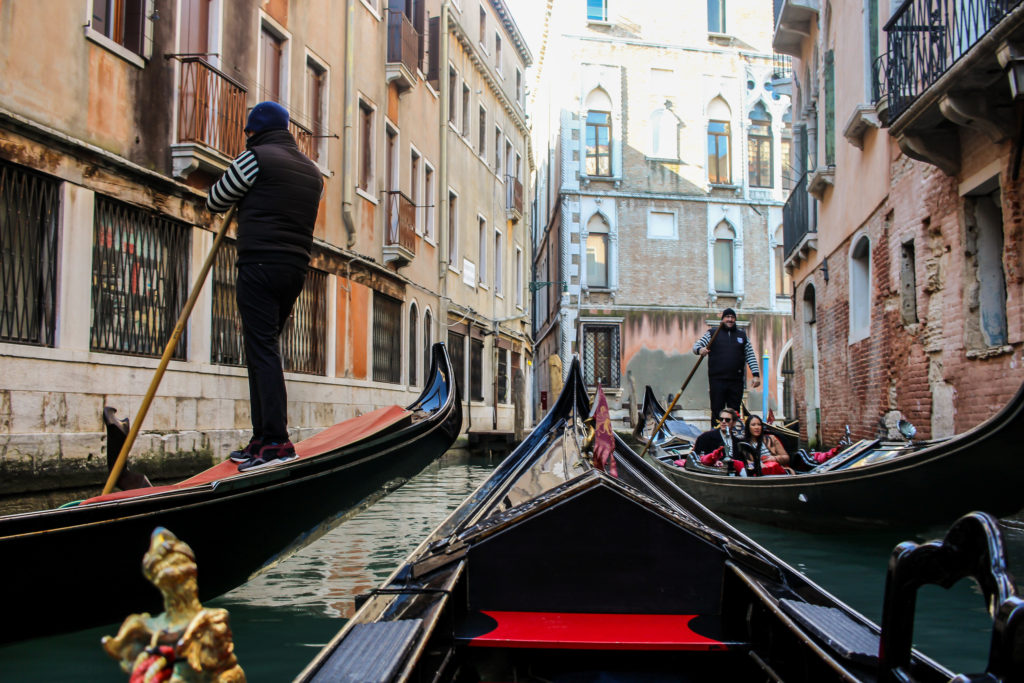
How Much is a Gondola Ride?
Make sure you bring lots of cash with you because gondola rides don’t come cheap. The price of a gondola ride is fixed, so there is no room for negotiation with your gondolier. They don’t set the prices personally and you’ll find the prices posted on signs, by the city, at the stops. Prices for a trip during the day, as of 2020, are 80€ for a 30 minute ride. It then goes up in increments of 20€ for every additional 20 minutes. If you’re wanting to go for a ride at night though prices are 120€ for 30 minutes and 50€ for every 20 minutes after that. This is a price per tour though and not per person. Gondolas can seat up to six people so if you’re there with friends or a group and don’t mind sharing with more people this is one way to reduce the cost.
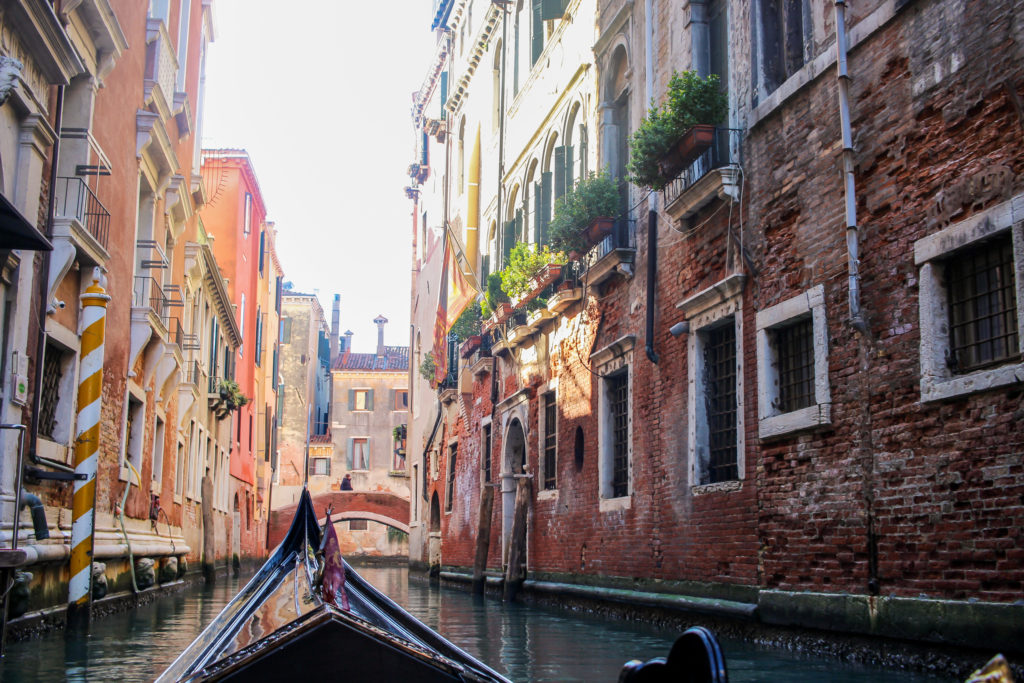
Is It Worth It?
Well, at the end of the day only you can answer this. I say absolutely. Venice is meant to be seen from the water. Taking a gondola ride through the canals is the only way to gain that perspective of this historic city. Not only are you getting these unique views but you have a professional local guide with you as well. As part of the tour your gondolier will point out all the key sites along the way. We passed by former palazzos, palaces which formerly housed Venice’s wealthy families. Our gondolier told us about the history of the palazzos and what they are used for today. Our gondolier really made the ride for us. He was super chatty, not only with us but with the other gondoliers as well. Each time we’d pass another gondolier he’d loudly and excitedly great them in Italian. It made the whole experience that much more fun. He even did a little singing and whistling while in the quieter sections of the canal. It was hauntingly beautiful to listen to him sing aria’s from Italian operas as he rowed through the empty canals, the sound echoing the whole way through. He even dabbled in a little throat singing, which was super unique. Not all gondoliers sing though, if it’s something you’d like during your ride, check with the gondolier first if he sings during the tour. Many people are put off by the price and if you are one of them, a gondola ride may not be for you. If you are like me and have been dreaming about this experience then you can’t pass it up. It was worth every penny.
Can You Book in Advance?
Yes, you can! The option to book ahead will be particularly helpful if you are visiting Venice during the high season or are looking for a specific tour. Plenty of online tour companies, such as Viator, and even your hotel concierge will let you book in advance. Both these options tend to be a little more expensive though. Online bookings are usually a per person price and when booking through your concierge there’s usually an additional booking fees. If you want to be serenaded during your ride or want to skip the long lines the extra money might be worth it.
Do Venetians Take Gondolas?
Gondolas are traditional Venetian boats and in the past it was a pretty big status symbol. They were a privately owned mode of transportation for the families of Venice. Gondoliers were respect members of society and they knew all the secrets of the aristocrats. Today however the vast majority of gondolas in Venice are for hire by tourists. Traditionally a Venetian will only take a gondola once in their lifetime, that is on their wedding day. Instead, Venetians will take a gondola da traghetto, or gondola ferry, when crossing the Grand Canal. Tourists can take these too. It costs about 2€ and the crossing only takes about 30-40 seconds. Impressively, locals usually do this ride standing up. Talk about a balancing act!
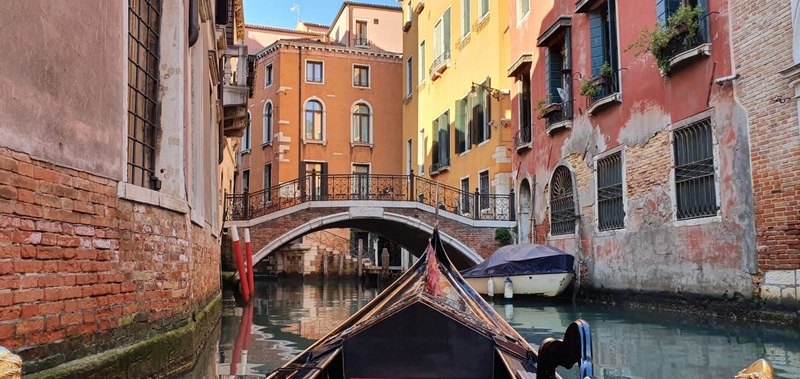
The Gondola’s Design
So, this is actually quite fascinating. The term “gondola” was first used in 1093 by the Doge at the time. The Doge of Venice was the elected chief magistrate and leader of the Republic of Venice. Boats similar to gondolas have been used since the early 900’s. When gondolas were privately owned, they were covered to protect the passengers from the weather and prying eyes. The covers were removed when tourists began taking gondolas because they blocked the view. The current design of the gondola has evolved to make it easier to maneuver through the narrow canals. They are handmade entirely of wood, are approximately 11 meters long and weigh up to 600kg. It can take up to six months to complete the build and will cost usually around 40000€ to buy.
The modern gondola features a lot of cool little things in its design, most interestingly it is asymmetrical. The asymmetry helps the gondolier balance when rowing. You’ll notice every gondola features the same metal decoration on the bow. This is called the Fero da Prova, and its design is symbolic of Venice. The curved shape at the top represents the hat of the Doge. There are six rectangles, one for each district of Venice and the three decorations between these rectangles are for the islands or Murano, Burano and Torcello. The bottom curve below the Doge’s hat is Rialto Bridge, the space between the bottom curve and the first rectangle is Saint Mark’s Basin. One rectangle on the back represents the island of Giudecca and finally the curve of metal that runs all the way down to the bottom of the boat is for the Grand Canal.
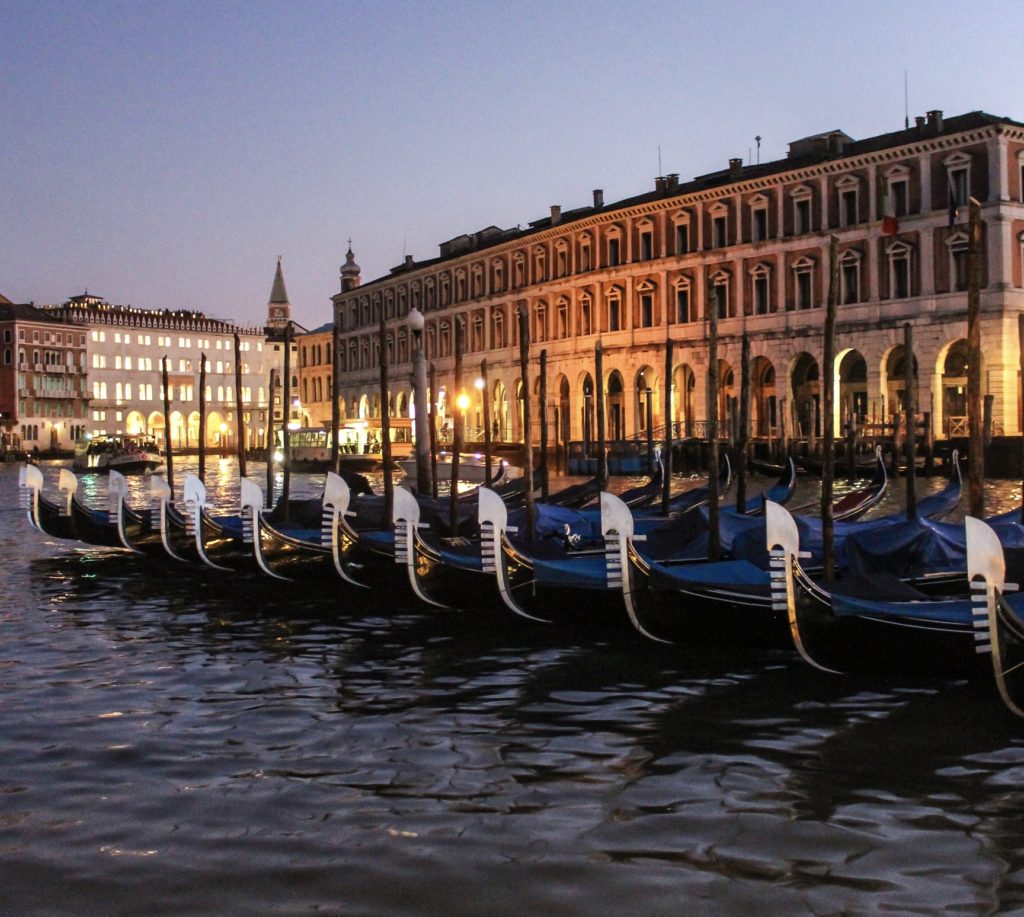
Becoming a Gondolier
To become a gondolier you must be trained and sworn in by the Gondolier’s Guild. The Guild is very secretive and surrounded by mystery. Not much is known about the guild or how you become a gondolier; but, it is highly unlikely that anyone will become a gondolier if they weren’t born in Venice. Traditionally, the trade was passed down from father to son. Today it still stays mostly in the family. It is still possible to become a gondolier without a family connection. You would just have to find a gondolier that is willing to take you on as an apprentice. This would usually be someone who doesn’t have son to pass the trade onto, or their son is not interested in the career. Gondolier hopefuls will undergo approximately 400 hours of training through the guild and rigorous testing in subjects like Venetian history and landmarks, foreign language skills and practical skills. It can take about six months to complete all the training and testing. If you pass the tests you are sworn into the guild and receive your gondoliers license. It is a very male dominated trade though. There is only one female who has passed the testing and become a licensed gondoliera.
Passing the practical skills exam must be no easy feat. There is a special technique to how gondoliers row and maneuver these boats. First off they use one long wooden oar to row. This oar also acts as their rudder and steers the boat. Gondoliers always stand on the right side of the oar and at the back of the boat to row. This is where those interesting design features come in. Remember the asymmetrical design? The left side of the boat is slightly wider to counteract the weight of the gondolier on the right. And the Fero da Prova on the front helps to balance the front of the boat.
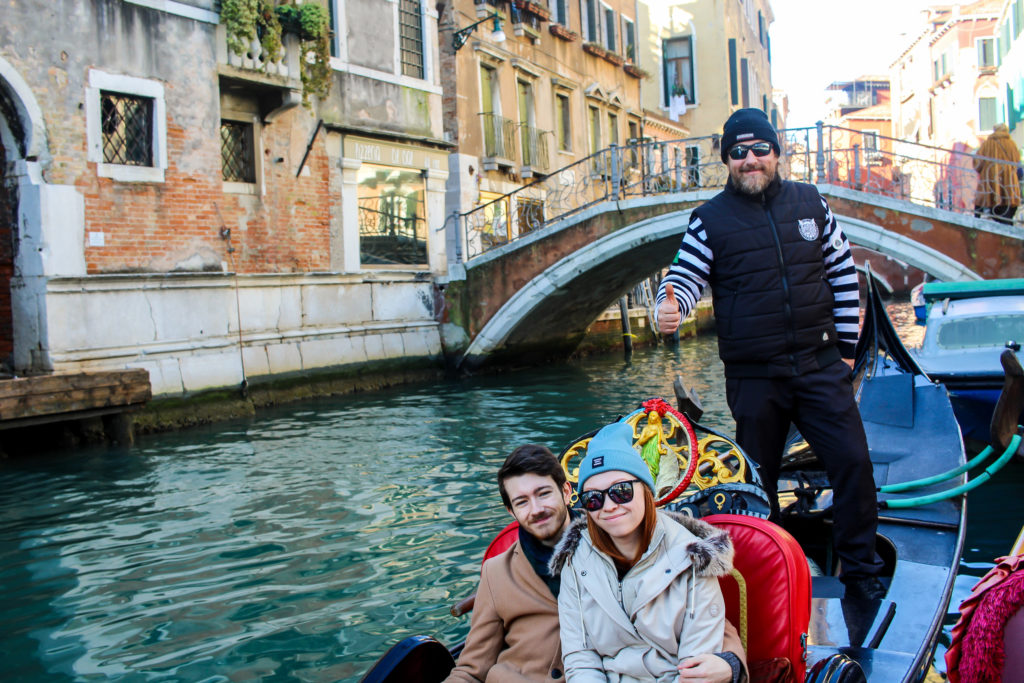
The Iconic Outfit
The gondoliers uniform is one of the most recognizable uniforms. Everyone knows the iconic red or blue striped shirts; but, these stripes are actually a fairly recent addition. Traditionally their outfit would have been all black to match the gondola. The striped shirts became a part of the uniform after World War II. No one is sure why the stripes were chosen: one idea is that the stripes were picked to match the mooring poles. All around the canals of Venice you will see striped poles at the entrances of the palazzos. These poles are called “pali da casada“, which means poles of the family. They were effectively mooring poles. Each set of poles was painted different colours often in a spiral stripe pattern. Sometimes they were painted one colour and featured the families coat of arms. Each palazzo had different colours and features to not only represent the family of that palazzo but it was to also help visitors recognize where they were at night. The traditional use of the poles is being lost now that the families no longer own gondolas. There are still many of these poles around Venice but their use is strictly ornamental.
Another reason why the striped uniforms may have been introduced was through French naval influence. The French navy introduced the stripped Breton shirt as their uniform in 1858. It was thought that the stripes would make it easier to spot a sailor who had fallen overboard. Some believe that the gondoliers adopted the stripes for similar reasons. As for the option between red or blue stripes, its up to the gondolier. In the past though, the colour of your stripes was thought to depend on what side of the canal you worked on. Either way, you can’t help but love the uniform. You can actually even purchase official gondolier apparel from the Emilio Ceccato shop near the Rialto Bridge.
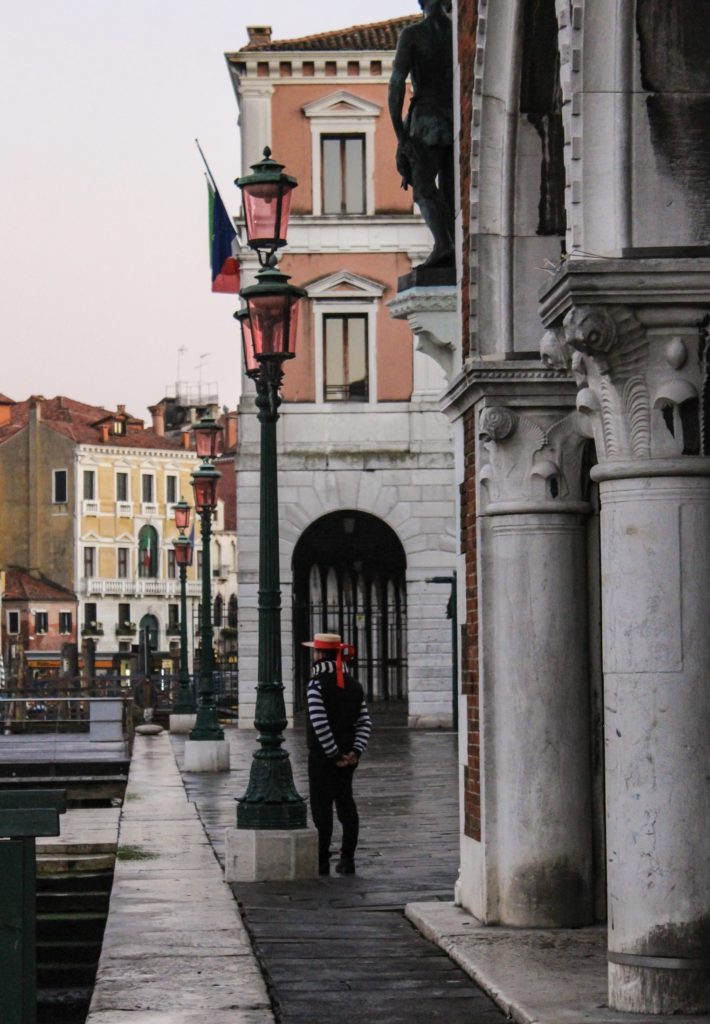
Why Are All Gondolas Black?
Unless you are at a regatta, where all the boats are painted bright colours, you’ll probably notice that all the gondolas are black. It wasn’t always like that though. As I had mentioned earlier, gondolas used to be a symbol of power for Venetian families. Eventually families began elaborately decorating their gondola. They invested a lot of time and money into having the most luxurious gondola on the canals. The Venice Senate stepped in to halt this craze and in October of 1562 passed a law forcing all gondolas to be painted black. You are still allowed to decorate the interior however you would like though and gondoliers take a lot of pride in keeping the inside well decorated and comfortable.
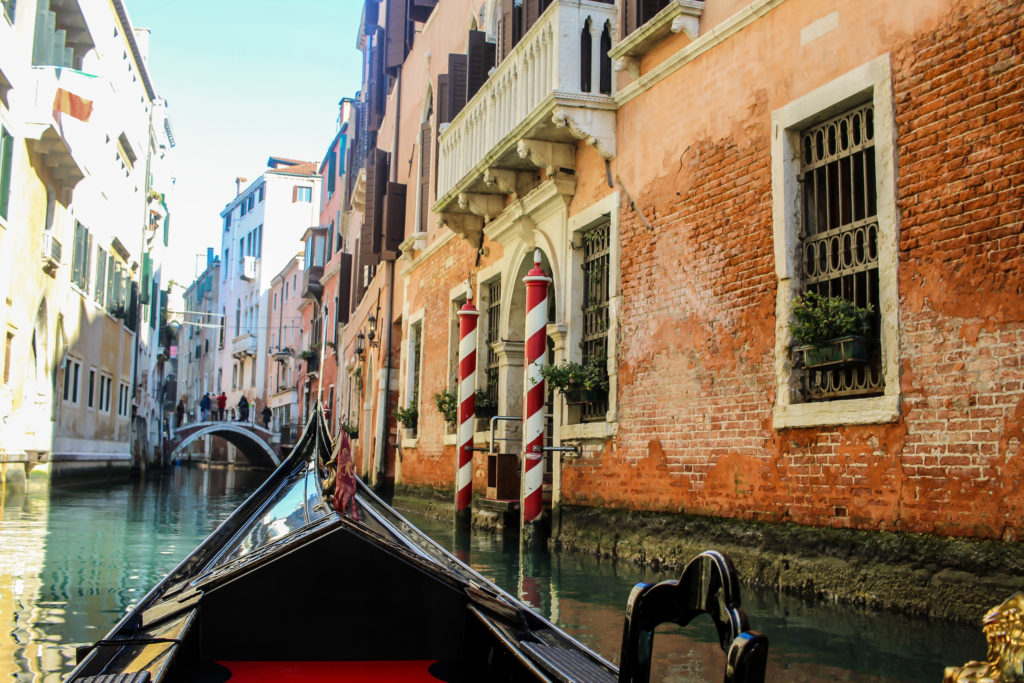
I had a lot of fun researching the history of these icons of Venice. I definitely learned a lot. I absolutely loved this beautiful little city and am looking forward to sharing my photos and experiences with you. Last week I finished my feature on Dublin and this is the start of my feature on Venice. Next week I’ll talk about visiting Murano and the crafts of Venice and then later I’ll put together my guide to Venice. If you want to stay up to date and see more photos you can find my on Facebook, Twitter, Instagram and Pinterest.
See you all next week. Ciao!
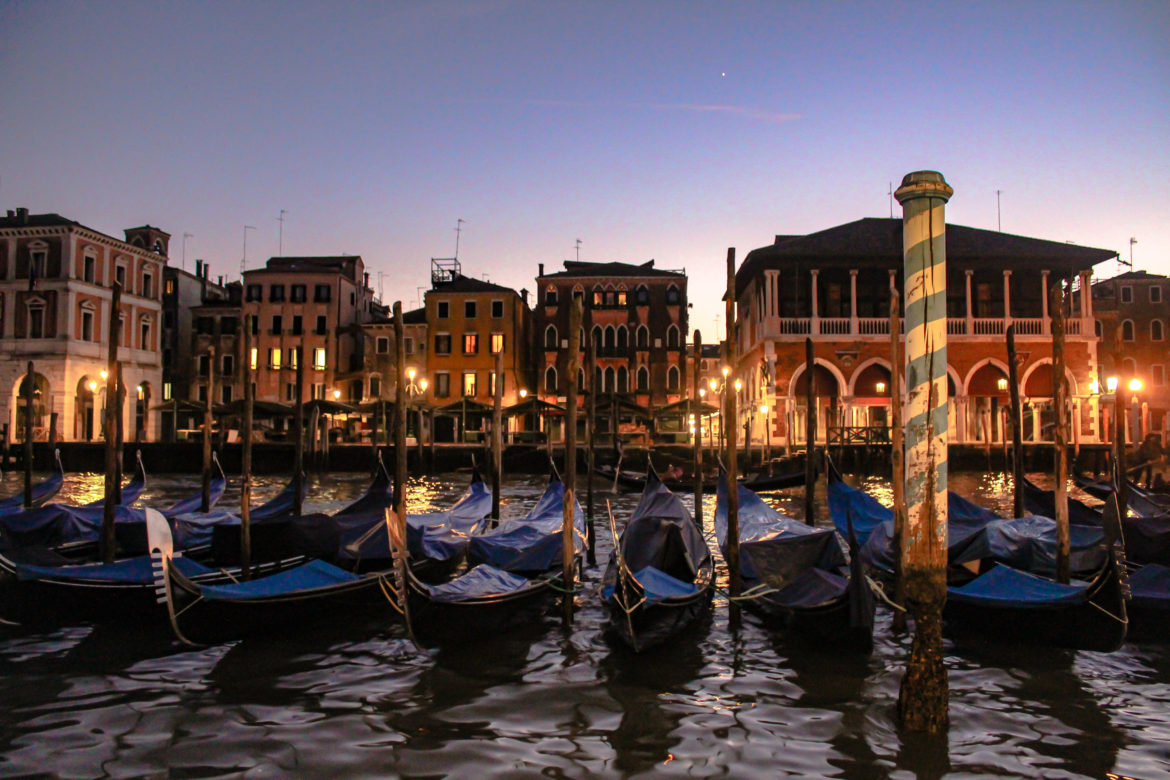
Very interesting and informative Calli. Wish we had known more about Venice before our visit. We should have researched it.
I was thinking the same thing while writing this. Before going I thought I knew everything I needed to know. Turns out I’d only scratched the surface and came back with so many questions about everything. I think that is one of the great things about Venice though, it’s so mysterious.